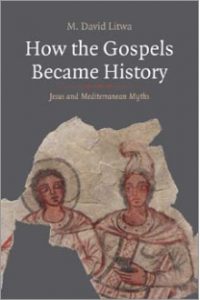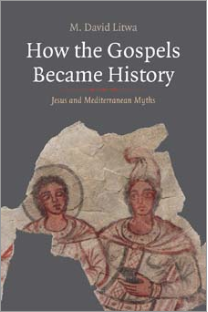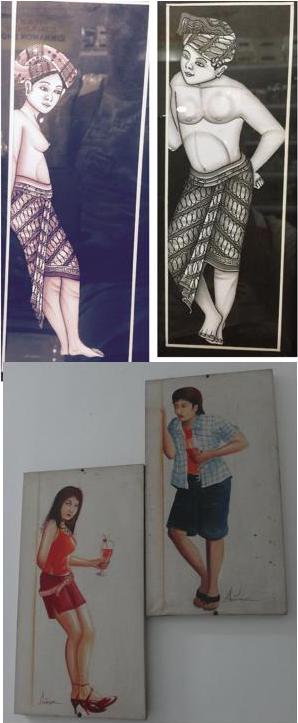 M. David Litwa’s concluding chapter is “The Myth of Historicity” and with this post I address the first half of that chapter. I have found the book, How the Gospels Became History: Jesus and Mediterranean Myth, most interesting, even though it has been a mixed journey, one that started more critical of the earlier chapters than of the later ones. Something of the same mix will be found in this final post as I sum up my responses to Litway’s thesis.
M. David Litwa’s concluding chapter is “The Myth of Historicity” and with this post I address the first half of that chapter. I have found the book, How the Gospels Became History: Jesus and Mediterranean Myth, most interesting, even though it has been a mixed journey, one that started more critical of the earlier chapters than of the later ones. Something of the same mix will be found in this final post as I sum up my responses to Litway’s thesis.
Litwa has identified in the previous chapters ten main tropes that serve as signals that the gospels were written to be read as historical narratives. He has noted that each of these ten is found in other Greco-Roman historical writings so it is reasonable to conclude the gospel authors, in deploying these tropes, likewise intended the gospels to be read as history. I list the ten here (from p. 210) with excerpts from the main text as illustrations. I follow with my review and thoughts on the points raised.
1. objectification (describing individually experienced phenomena as if they were fully knowable and observable by others)
A good example of objectification is the description of Jesus’s resurrection appearances. In origin, these appearances were perhaps visions experienced by early Christians either individually or in a group setting. Yet these visions came to be described as palpable events that occurred in space and time. Eventually, Jesus’s luminous body seen in visions became more solid in the act of historiographical retellings. Despite its ability to walk through walls, the body began to be depicted as “flesh and bone” (Luke 24:39), able to be poked and prodded by eyewitnesses—including the famous “doubting Thomas” (John 20:24—28). (p. 10)
2. synchrony (noting well-known persons or occurrences);
There are other historicizing tropes that increase the “reality effect” of the gospels.57 Synchrony, for instance, is the mention of famous persons who lived at the same time as the depicted hero. The third evangelist, for instance, mentioned the governor of Syria, Quirinius, as a contemporary of Jesus (Luke 2:2). This author wrongly dated the rule of Quirinius by about a decade, but the very mention of him as a well-known ruler (along with the then universally known “Caesar Augustus”) increased the realism of his tale. (p. 10)
3. syntopy (mentioning known places on the map);
A similar trope might be called syntopy, the mention of real and familiar places. The evangelists placed Jesus in Galilee under the administration of a historical Jewish king (Herod Antipas). The third evangelist intentionally clarified elements in an earlier evangelist’s topography (Luke 8:26 and Mark 5:1; Luke 4:31 and Mark 1:21) and added a travel narrative showing a discrete move from Galilee to Jerusalem (Luke 9:51-19:28). (p. 11)
4. straightforward, matter-of-fact presentation (which often frames the description of fantastical or anomalous events);
Likewise, Jesus’s sea-stilling miracle is stated in the matter-of-fact tone of historiography: “Jesus got up, rebuked the wind and said to the sea: ‘Shut up, be muzzled!’ Then the wind died down and there was a great calm” (Mark 4:39).11 In fact, Jesus seems rather grumpy after being awoken— another peculiarly human trait. His sea-stilling is fabulous, to be sure, but within the range of possibility for the “son of God” (Mark 3:11). Wind and sea are rebuked, but they are not personified. The timing is precise: Jesus calms the storm in the evening after a long day of weaving parables. The route can be traced on a map: Jesus sails across the Sea of Galilee to the region of the Gerasenes (Mark 5:1). It does not matter that Gerasa (modern Jerash) is thirty-seven miles southeast of the Sea of Galilee (no one but scholars seem to notice); what is important is that the geographical marker is there. The temporal and chronological markers generate a historical frame, a frame that soothes the turbulence of the miracle and fosters the calm of astounded belief. (p. 144)
5. vivid presentation (which includes the addition of random and circumstantial details) and the rhetoric of accuracy akribeia, which includes . . .
There are other vivid details in John that could easily be thought to go back to historical reminiscence: John the Baptist was baptized at Aenon near Salim (John 3:23); the lame man lay for thirty-eight years at the pool of Beth-zatha (5:3 —5); the slave whose ear was cut off was named Malchus (18:10); Peter stood at a charcoal fire outside Annas’s house during Jesus’s trial (18:18). The biblical scholar Paul N. Anderson claims, ‘John has more archaeological, topographical, sensory-empirical, personal knowledge and first-hand information than all of the other gospels combined.” Such vivid presentation (what the Greeks called enargeia) was a known technique of historiographical discourse. (p. 203)
6. . . . the introduction of literary eyewitnesses (such as the Beloved Disciple);
Despite the unlikelihood of the evangelists being eyewitnesses, at least one of them indicates that he based his material directly on an identifiable eyewitness who appears as a character in his story. Late in the fourth evangelist’s account, he introduces an unnamed figure whom he refers to as “the disciple whom Jesus loved.” This disciple, who appears nowhere else in gospel literature, is portrayed as one of Jesus’s most intimate companions. At the Last Supper, the Beloved Disciple rests his head on Jesus’s breast (John 13:21-25). This posture represents a privileged, intimate relationship mirroring Jesus’s own relationship with his Father, in whose bosom he abides (John 1:18). (p. 196)
7. staged skepticism among the eyewitnesses (as in Matt. 28:17; John 20:25);
The author of Matthew noted that some of Jesus’s eleven disciples doubted the resurrection even when they saw him physically present (Matt. 28:17). (p. 191)
Thomas had declared, “Unless I see the nail wound in his hands, thrust my finger into the nail wound, and thrust my hand into his side, I will not believe.” A week later, Thomas was staying in a locked room when Jesus walked through the walls. Admittedly, this was not a good way to prove Jesus’s materiality. Still, the hero approached Thomas and said, “Thomas, place your finger here; observe my hands, then bring your hand and thrust it into my side” (John 20:25-27). Thomas instantly realizes that Jesus is not a ghost but a god (John 20:28). (p. 184)
8. alternative reports (as in Matt. 28:13);
Despite the added story of Jesus’s appearance, reports of fraud arose. The disciples were rumored to have stolen the body (Matt. 28:13). In Matthew, this report is implicitly belittled since the disciples would have needed to subdue the well-trained and heavily armed Roman guard. (p. 174)
9. stated links of causation (as in Matt. 28:15);
In providing this alternative tradition, the Matthean evangelist used the language of historical causation. The conniving Jewish leaders created the theft story; hence it continues to persist. Although this evangelist preferred to explain the missing body by narrating resurrection appearances, the fact that he offered an alternative report is significant. Providing such a report was a common historiographical technique. Offering the reader a choice between the reports gave the (albeit fleeting) impression of objectivity. (p. 175)
and . . .
10. . . . literary traces of a past event (such as tomb tokens).
Contrary to the suspicion of modern skeptics, they do not go to the wrong tomb. They recognize the right tomb by the presence of Jesus’s personal items, namely, the linen wrappings that formerly covered his body and a neatly folded cloth that covered his face (John 20:5-7). These details undercut the supposition that the body was stolen, since robbers would presumably not have taken the time to carefully fold Jesus’s face cloth. (p. 176)
Not unique to history
As discussed in the earlier posts these techniques are not exclusive to works of ancient history and biography but are also found in mythical-poetic works and even in fictional novellas, both “historical” and “erotic (=love stories)”.
One more — the everyday human setting
An elaboration can be made to some of Litwa’s above ten: e.g. the “objectification”, the “straightforward, matter-of-fact presentation”, as well as the references to “well-known persons” and “places on the map”, are brought to bear in very ordinary, everyday human life contexts, such as inviting guests in for a meal. The “vivid presentation” is not always there (not even the crucifixion of Jesus is described as graphically as it could be) but the “random and circumstantial details” are part and parcel of the miraculous or mythical events taking place as “by the way” events in mundane human settings.
One difference — no room for doubt
So yes, the way the miraculous events of the gospels were told does coincide in many, but not all, respects with the way they were told in ancient histories and biographies. The exception: ancient historians and biographers generally related the miraculous events with some authorial distance, expressing in various ways a concession that readers were free to doubt the truth of miraculous events. Not so the gospels.
“Alternative reports” compared with different biblical narratives Continue reading “Review, conclusion #1: How the Gospels Became History / Litwa”
Like this:
Like Loading...





